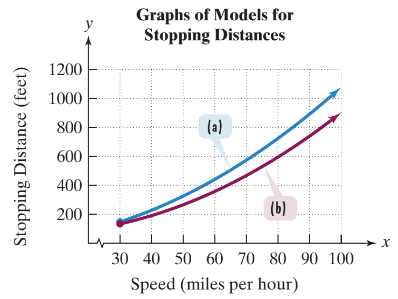
Concept explainers

a. Use the given functions at the bottom of the previous page to find the slopping distance on dry pavement and the stopping distance on dry pavement for a car traveling at 55 miles per hour. Round to the nearest fool.
b. Based on your answers to part (a), which rectangular coordinate graph shows slopping distances on dry pavement and which shows slopping distances on wet pavement?
c. How well do your answers to part (a) model the actual slopping distances shown in Figure 3.43 on page 431?
d. Determine speeds on wet pavement requiring slopping distances that exceed the length of one and one-half football fields, or 540 feet. Round to the nearest mile per hour. How is this shown on the appropriate graph of the models?
Want to see the full answer?
Check out a sample textbook solution
Chapter 3 Solutions
EBK ALGEBRA AND TRIGONOMETRY
- Solve by the quadratic formula or completing the square to obtain exact solutions. 2 e 104 OA) -16±3√6 B) 8±√10 O c) -8±√10 OD) 8±3√√6 Uarrow_forwardQuestion 14 (1 point) Listen The frame on a picture is 18 in by 22 in outside and is of uniform width. Using algebraic methods, what is the width of the frame if the inner area of the picture shown is 250 in²2? Write answer to 2 decimal places. (Write the number with no units). 18 in Your Answer: 22 inarrow_forward◄ Listen A vacant lot is being converted into a community garden. The garden and a walkway around its perimeter have an area of 560 square feet. Find the width of the walkway (x) if the garden measures 15 feet wide by 19 feet long. Write answer to 2 decimal places. (Write the number without units). X 15 feet Your Answer: 19 feet Xarrow_forward
- Listen A stuntman jumps from a roof 440 feet from the ground. How long will it take him to reach the ground? Use the formula, distance, d = 16t2, (where t is in seconds). Write answer to 1 decimal place. (Write the number, not the units). Your Answer:arrow_forwardSolve x² - 10x + 24 = 0 ○ A) 4,6 B) -12, -2 C) 12,2 D) -4, -6arrow_forwardc7. = -(9 - x) 25 A a) -1, 11 b) 31 c) 11 d) 1, 11arrow_forward
- 2 4x² - 12x-7=0 A) 7 ON 1,-1 4 OB)-, 7 1 C) 2,2 Oa½½-½ c) 17/17, - 1/1/1 D) 2, 2 ODI-,-arrow_forwardSolve using the quadratic equation formula 4x² + 12x=-6 ○ a) -12±√√3 2 b) -3±√15 -3+√15 2 ○ c) c) -3±√√√3 2 d) -3±√3 8arrow_forwardListen Solve the quadratic equation by factoring. One solution is 0. Find the other. 2x² + 16x = 0 Your Answer: Answerarrow_forward
 Holt Mcdougal Larson Pre-algebra: Student Edition...AlgebraISBN:9780547587776Author:HOLT MCDOUGALPublisher:HOLT MCDOUGALAlgebra & Trigonometry with Analytic GeometryAlgebraISBN:9781133382119Author:SwokowskiPublisher:Cengage
Holt Mcdougal Larson Pre-algebra: Student Edition...AlgebraISBN:9780547587776Author:HOLT MCDOUGALPublisher:HOLT MCDOUGALAlgebra & Trigonometry with Analytic GeometryAlgebraISBN:9781133382119Author:SwokowskiPublisher:Cengage Glencoe Algebra 1, Student Edition, 9780079039897...AlgebraISBN:9780079039897Author:CarterPublisher:McGraw Hill
Glencoe Algebra 1, Student Edition, 9780079039897...AlgebraISBN:9780079039897Author:CarterPublisher:McGraw Hill College Algebra (MindTap Course List)AlgebraISBN:9781305652231Author:R. David Gustafson, Jeff HughesPublisher:Cengage Learning
College Algebra (MindTap Course List)AlgebraISBN:9781305652231Author:R. David Gustafson, Jeff HughesPublisher:Cengage Learning Algebra: Structure And Method, Book 1AlgebraISBN:9780395977224Author:Richard G. Brown, Mary P. Dolciani, Robert H. Sorgenfrey, William L. ColePublisher:McDougal Littell
Algebra: Structure And Method, Book 1AlgebraISBN:9780395977224Author:Richard G. Brown, Mary P. Dolciani, Robert H. Sorgenfrey, William L. ColePublisher:McDougal Littell Functions and Change: A Modeling Approach to Coll...AlgebraISBN:9781337111348Author:Bruce Crauder, Benny Evans, Alan NoellPublisher:Cengage Learning
Functions and Change: A Modeling Approach to Coll...AlgebraISBN:9781337111348Author:Bruce Crauder, Benny Evans, Alan NoellPublisher:Cengage Learning





